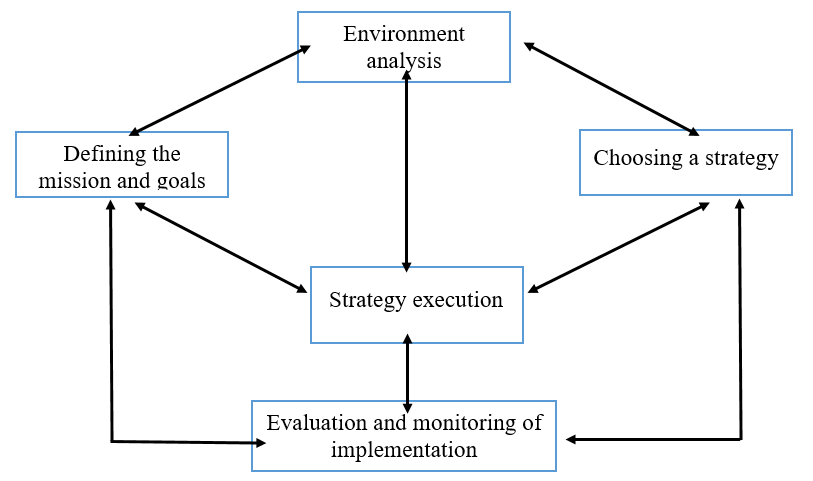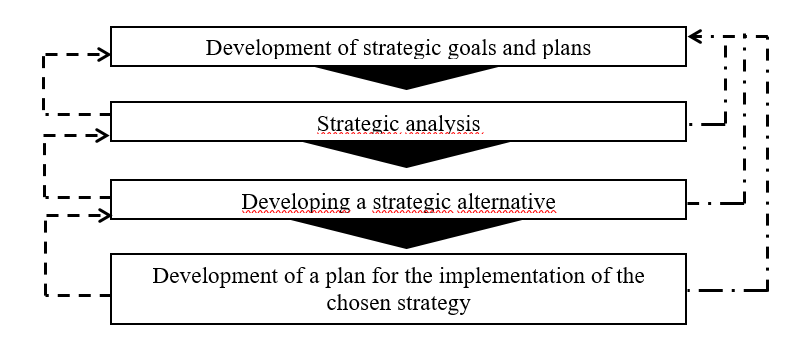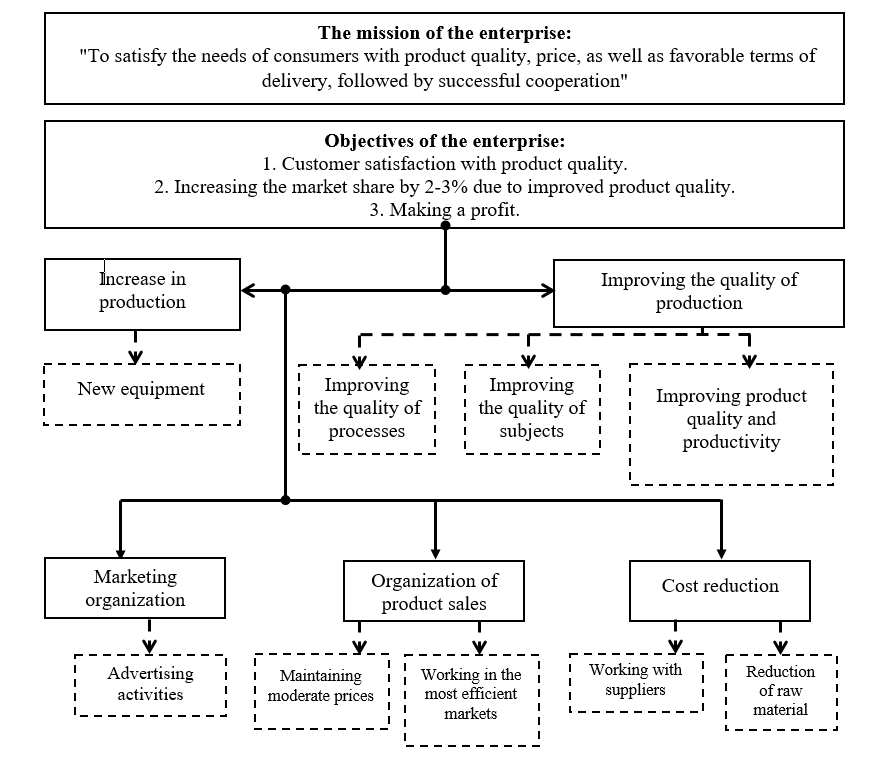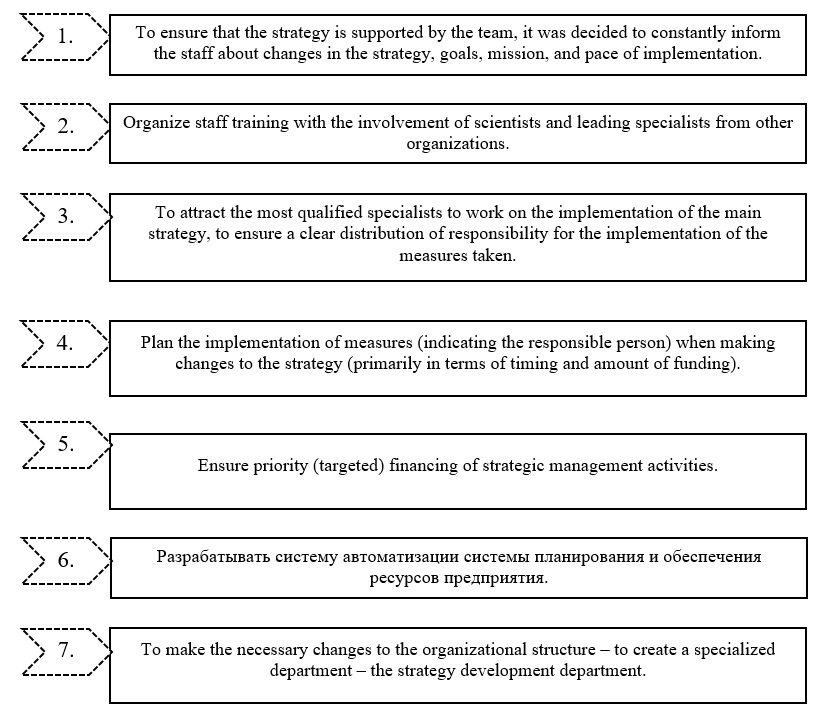Abstract
Содержание
- Introduction
- Relevance of the topic
- 1. Theoretical aspects of the formation and implementation of the enterprise strategy
- 2. Formation of measures to improve the development strategy and its implementation
- Conclusions
- References
Introduction
In the management of an organization, strategy is considered as a long-term, qualitatively defined direction of the organization's development in relation to the goals, means and forms of its activities, the system of relationships within the organization, as well as the position of the organization in relation to the environment, to guide the organization to its goals. Strategy is a set of rules that an organization follows when making management decisions to ensure the implementation of the mission and achieve the business goals of the organization. If the goals of the organization determine what the organization is striving for, what it wants to achieve as a result of its activities, the strategy gives an answer to the question of how and by what actions the organization will be able to achieve its goals. in a changing and competitive environment. [1]
Цель исследования - разработка мероприятий по совершенствованию стратегии развития предприятия.
Research objectives:
- To analyze the theoretical and methodological foundations of the formation and implementation of the enterprise development strategy.
- To investigate the current development strategy of LLC "TECHPROM".
- To develop measures for the development of the development strategy of LLC "TECHPROM" and its implementation.
- To analyze the harmful factors of production during the operation of a PC, as well as to study the issues of life safety and civil defense.
The object of the study: Amvrosievsky plant of asbestos cement products LLC "TECHPROM".
Subject of research:methodological approaches to the development and improvement of the enterprise development strategy.
Relevance of the topic
The implementation of the new strategy begins with a series of changes in the organization. After all, without them, even the most effective strategy will not bring good results. Making changes to the organization is the basis for the implementation of the strategy. Changes can be understood as the decision of the management to make changes to the structure, goals and objectives of the organization caused by new conditions of the external and internal environment. To ensure the stable growth of the organization, it is necessary to periodically assess the effect of the changes made and adjust the development trend. Most often, the need for changes appears only with the help of a management system.Each organization, developing an individual strategy or a group of strategies, strives to organize its activities in such a way that the effectiveness of all internal processes is maximized.
Each organization, developing an individual strategy or a group of strategies, strives to organize its activities in such a way that the effectiveness of all internal processes is maximized. In order to determine the behavioral strategy of an organization and apply this strategy in practice, management must have a complete understanding not only of the internal environment of the organization, its potential and development trends, but also of the external environment, its development trends and its place. the organization in it. At the same time, the external environment is studied by strategic management mainly in order to identify threats and opportunities that the organization should take into account when determining its goals and achieving them.
The choice of a specific direction of strategy change means that of all the possible ways to adjust the strategy that opened up to the enterprise, it was decided to choose one direction that is the most appropriate. New actions and approaches will show possible ways to change and transform the current strategy.
But there is no single strategy for all organizations. Each organization is unique in its own way, therefore, the process of developing a strategy for each organization is individual, because it depends on the position of the organization in the market, the dynamics of its development, its potential, the behavior of competitors, the characteristics of the goods produced or services rendered, the state of the economy, the cultural environment, etc.
Thus, the development of a corporate strategy is an urgent problem and a necessary task for the most effective work of the organization.
1. Theoretical aspects of the formation and implementation of the enterprise strategy
Strategic management can be considered as a dynamic set of five interrelated management processes [2]. These processes interact with each other. However, there is a stable feedback and, accordingly, the reverse effect of each process on the rest and on their totality [4]. This is an important feature of the strategic management system

Figure 1 – Strategic management structure
The main stages of strategy development.
Depending on the complexity and scale of the enterprise's business, the format of the development and the volume of the prepared strategy description may vary significantly [3]. For example, the development strategy of a small entrepreneurial company is usually developed as part of a one-day or two-day strategic lesson. And the strategy of a large corporation is usually developed for several months with the active involvement of strategic consultants [6]. The main stages of developing a business development strategy, as a rule, remain the same [6]

Figure 2 – The main stages of the development of the enterprise strategy
In practice, an enterprise can simultaneously implement several strategies [3]. In this case, they say that the company is looking for a combined strategy.
2. Formation of measures to improve the development strategy and its implementation
In order to concretize the achievement of goals, it is necessary to build a "Goal Tree" so that it is better to see what exactly needs to be done.

Figure 3 – The tree of goals of LLC "TECHPROM"
In this case, we see a "narrow" approach to the formulation of the mission. It is used by enterprises if their goal is to make the most effective use of strategic advantages and specialization in the production of certain types of products, the provision of services and the achievement of results in certain markets.Such a mission statement gives the company a certain monopoly share among the interested groups for a fairly well-defined product category, especially since. Thus, both the company's employees and its customers have a clear understanding of the company's position in the market and have strong ties with its business, regardless of the geographical region.
This is a well-formulated mission of the enterprise, customer-oriented, which takes care of the "successful organization and business management" of clients.

Figure 4 – Measures to implement the strategy
Conclusion
Any business exists in a dynamically changing environment, and a strategy is simply necessary to build a business in accordance with general long-term plans and current specific plans, with a specific current situation, with specific partial results achieved at lower levels, adjusting the strategy in accordance with the partial results and the situation. If the internal and external environment were static and predictable, no strategy would be required. In strategic management, the issues of evaluating the results of private activities, internal and external environment are of particular importance. Without this, management is impossible, mainly strategic, covering planning horizons from three to five years or even more at higher levels.
For LLC "TECHPROM" in the Donetsk People's Republic, the most acceptable is the search for the optimal combination of options, development based on a synthetic approach to optimizing production and management, therefore, the stages of optimizing the strategy of LLC "TECHPROM" are proposed. Thus, the implementation of the proposed measures is an integral part of solving the main task of the enterprise – continuous and harmonious development.
When writing this abstract, the master's work has not yet been completed. Final completion: June 2022. The full text of the work and materials on the topic can be obtained from the author or his supervisor after the specified date.
References
- Алексеенко, А.А. Выбор стратегии управления предприятием на основе SWOT-анализа // Социальные науки. - 2017. - № 1. - С. 63 - 66.
- Агафонов, В. А. Стратегический менеджмент. Модели и процедуры: Монография / В.А. Агафонов. - М.: Инфра-М, 2019. - 350 c.
- Ажаханова, Д. С. Современные подходы к стратегическому управлению // Современные тенденции в экономике и управлении: новый взгляд - 2018. - № 19. - С. 16 - 18.
- Филатова, Е.В. Роль стратегии управления в развитии предприятия / Е. Филатова // Инновационное развитие и промышленная политика: Сборник материалов II всероссийской научно-практической заочной конференции. – Биробиджан: Дальневосточная Государственная Социально-гуманитарная Академия, 2016. - С. 25-29.
- Гребенкова, Е. А. Экономическое развитие Донецкого региона / Е. А. Гребенкова, Р. И. Балашова // Стратегия устойчивого развития в антикризисном управлении экономическими системами : сб. материалов II междунар. науч.-практ. конф., 20 апр. 2016 г., г. Донецк / ГОУВПО "ДОННТУ", Каф. менеджмента и хоз. права, Каф. экон. кибернетики. - Донецк, 2016. - Секция 1. – С. 194-196.
- Романюк Н.В. Особенности мотивации персонала на предприятиях различных сфер деятельности / Н.В. Романюк, Ю.В. Водолазская // Материалы II Национальной научно-практической конференции (Керчь, 27 октября 2020 г.) / / под общ. ред. Е.П. Масюткина. – Керчь: ФГБОУ ВО «КГМТУ», 2020. – С. 369-374.
- Романюк Н.В. Формирование системы стратегического управления персоналом в современных условиях / Н.В. Романюк, Е.А. Романюк, Ю.В. Водолазская // материалы VIІ Международной научно-практической конференции, г. Донецк, 8 апреля 2021г. /отв. ред. О.Н. Шарнопольская, И.А. Кондаурова, Е.Г. Курган / ГОУВПО ДОННТУ. – Донецк: ДОННТУ, 2021. – С. 435-442.
- Романюк Н.В. Стратегический анализ промышленного предприятия Донецкой Народной Республики / Н.В. Романюк, Ю.В. Водолазская // материалы XII Международной научно-практической конференции «Экономические, экологические и социальные проблемы промышленных регионов», г. Краснодон, 26-27 мая 2021 г. – Краснодон: ЛГУ им. В.Даля, 2021.
- Коробов, Д.Ю. Метод SWOT-анализа в стратегическом управлении / Д. Коробов // Журнал научных и прикладных исследований. - 2016. - № 1. - С. 21 - 22.
- Жемчугов, А.М. Современный менеджмент. Четыре уровня цели и стратегии, единство и противоположность составляющих / А. Жемчугов // Проблемы экономики и менеджмента. - №12. - 2013. – С. 21-24.
- Филипенко Д.Е., Воронцова Г.В. Проблемы повышения эффективности управленческих решений в условиях кризиса // Материалы. IV Международной научной конференции студентов, аспирантов и молодых ученых «Научный потенциал студенчества в XXI веке». - Ставрополь: СевКавГТУ, 2010. – С. 492 - 495.
